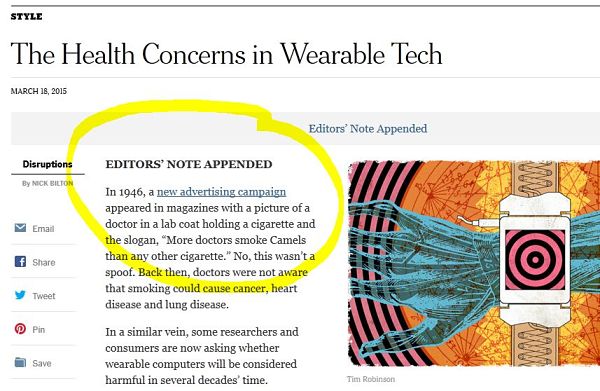What a Half-Baked News Article Tells Us About Explaining Research
 A columnist at the New York Times has written that he believes that technologies like Apple’s upcoming watch could be as as dangerous as cigarettes and cause cancer. The idea, and the evidence that the New York Times columnist Nick Bilton presented, has been universally panned. Not only by a range of publications like Wired, The Verge and Slate amongst many others, but by the New York Times itself. Margaret Sullivan, the New York Times public editor, has called foul over the article, pointing out that Bilton shouldn’t have been commenting on science, which he clearly knew nothing about, and the editor should not have used a headline that was constructed as “click bait.”
A columnist at the New York Times has written that he believes that technologies like Apple’s upcoming watch could be as as dangerous as cigarettes and cause cancer. The idea, and the evidence that the New York Times columnist Nick Bilton presented, has been universally panned. Not only by a range of publications like Wired, The Verge and Slate amongst many others, but by the New York Times itself. Margaret Sullivan, the New York Times public editor, has called foul over the article, pointing out that Bilton shouldn’t have been commenting on science, which he clearly knew nothing about, and the editor should not have used a headline that was constructed as “click bait.”
The article appeared in the Fashion and Styles section of the online paper and the title comparing wearables to cigarettes was eventually changed to the less incendiary “The Health Concerns in Wearable Tech.” The editor of the Fashion section subsequently responded to criticism and posted an editor’s note that basically retracted everything said in the article.

This article by David Glance originally appeared at The Conversation, a Social Science Space partner site, under the title “The NY Times declares wearables cause cancer – a fail for journalism or science?”
What was interesting however, was the way Bilton’s critics picked apart his arguments. Much was made, for example, about how Bilton framed his argument as relying on scientific evidence when in reality he was taking one or two inconclusive reports out of a expanse of other un-supportive research to try and prove his point. Bilton also was called out for relying on the opinion of someone who was not a scientist but was rather an “alternative practitioner” called Joseph Mercola. In the past, Mercola has advocated that almost everything can cause cancer or other harm, including mammography, fluoridation, amalgam fillings and even sunscreen.
In many ways, Bilton’s arguments followed a very similar line to those espoused by others claiming that vaccinations cause harm and that climate change has no scientific basis.
The truth is, we really don’t know at this time whether there are any long-term harmful effects of using mobile phones, let alone wearables. The fact that the mere suggestion that there is a danger caused the outcry that it did, says more about the anti-science triggers encoded in the article than the actual debate about whether the claim was actually true. In the end, it really didn’t matter what Bilton was arguing, just that he was abusing science and that put him in a particular camp of people who do this for a living.
The fault in misunderstanding could also partially lie with the way science itself is distilled in the form of papers in journals
What perhaps this story points to is the difficulty in trying to distill scientific research into a form that is understandable and can be communicated to the public. This is, in an of itself, a difficult task because a great deal of fidelity is lost in the simplification. Using this simplified model to make an argument however is an almost impossible task. This is especially the case when amateurs confuse the idea that referencing and citation are the only hallmarks of the scientific process.
The fault in misunderstanding could also partially lie with the way science itself is distilled in the form of papers in journals. As Wired pointed out, the use of hedge terms like “possibly”, “inconclusive” and “needs more research” are just that, filler terms that scientists add to suggest that they really don’t know all of the answers but if someone cares to fund them, they will do more research to find out. They simply mean that we don’t know, not that there is any evidence to suggest that it is actually possible.
Ultimately, scientists themselves should be doing a better job at making research accessible to the public so that these misunderstandings don’t occur. They should be in the best position to know what is and isn’t known and all that is needed is for this to be put in a form that the public understands. If that was done, we wouldn’t need technology columnists, even those who work for the New York Times, failing to do it for them.![]()





















































































